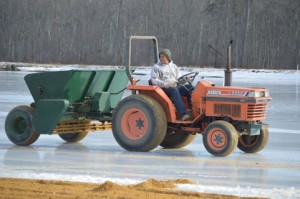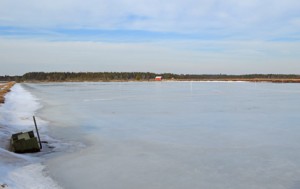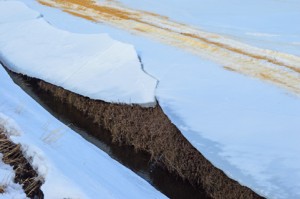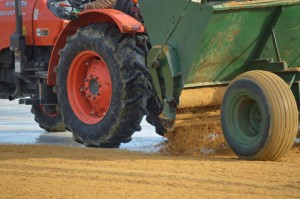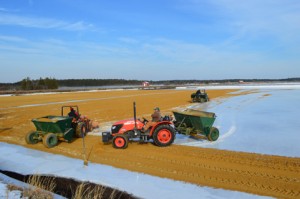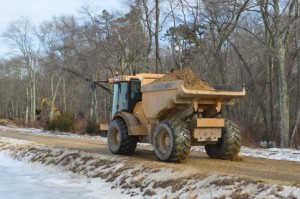Until this week’s snow, the weather has been both clear and cold enough that our team has been able to work toward our sanding target via the ice sanding method. A brief recap: sanding is a fundamental component of our Pine Island Integrated Crop Management (PIICM) program, helping us manage the relationship between water, soil, weather, disease, insects, weeds, and nutrition. This procedure helps improve growth and yield by stimulating the development of new uprights (covering the base of the roots strengthens the root system and creates a more healthy vine) while also suppressing disease and reducing insects (by burying weed seed, spores, and insect eggs). It also improves soil drainage while at the same time absorbing and releasing heat so that frost danger in spring is lessened. This increases our efficiency by lowering the need for extra plant nutrition as well as saving water by cutting down frost irrigation times.
“We can sand under colder conditions with ice sanding,” explains GM Fred Torres. “We were out there when it was 20 degrees. You can’t do that on the water; as the barge is moving, water and sand are splashing onto the rollers underneath. If that freezes, it can cause a lot of problems. That won’t happen on ice.” To prep the bog for ice sanding, the ice needs to be at least five or six inches thick. Then the team drops the water underneath, leaving the ice to sit on the vines (protecting them from the elements) until the sanding is done.
“It was great to be out there,” says supervisor Matt Giberson. “We haven’t been sanding in what feels like forever.” He notes that while there are similarities (“The cleaner the sand, the better off you’ll be”), there are certain things that need to be adjusted as they go. The ice sanding team is using three different tractors, so there are always pacing adjustments. “It’s a little different than just measuring the distance on the barge. Some of the traction on the tractors was different; the newest one has better traction. The older tractors have turf tires, so they were slipping when they first started. But when we’re out there, everyone is communicating, and it makes us that much more efficient.” Matt added that CEO Bill Haines came out to see him with some suggestions for improving the workflow by re-routing the Hydremas when loading sand, and it sped things up considerably. “The Hydremas work so much better on the dams anyway, especially in this weather,” he says. “We’re getting a lot more hauling done.”
“Ice sanding is like painting a wall,” Fred says. “You can see if you missed a spot and go back to touch it up!” And as long as the weather cooperates, our team will be able to finish by their targeted date.

